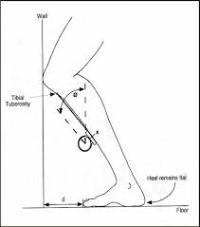Ankle Dorsiflexion and Active Release Techniques (ART)

Shannon Turley, the Stanford University Strength Coach, was profiled in New York Times and Bleacher Report articles recently. When asked what N.F.L. scouts should focus on, he said, “ankle mobility, the ankle begins the chain of movement“. Ankle mobility is often limited in athletes without the athlete even being aware of it. Dorsiflexion is the movement of the foot towards the shin. If one side is particularly limited then it is vital to address this issue before the body starts to compensate, which can cause dysfunction elsewhere.
A 2014 study of infantry recruits doing intense training found a link between decreased ankle dorsiflexion (with knee bent) and Achilles tendinopathy.
In 2011, there was a study by Backman et al. which tested basketball players for decreased ankle dorsiflexion, the players with decreased dorsiflexion were much more likely to have knee pain within a year.
The basics:
- how to check if normal
- self treatment using a foam roller
- mobilization drill
- PNF stretching which a recent study concluded was very effective after a 6 week program.
- prone scoop manipulation works every time
In my opinion, the best way to make a more lasting change in ankle dorsiflexion is by using Active Release Techniques (ART). I use ART on elite athletes every day to improve dorsiflexion. What separates ART from other approaches is the ability to isolate and treat the ankle ligaments (and work between muscles) which are often the problem. Of course the soleus often restricts dorsiflexion, but this study demonstrated why treating the gastrocnemius in isolation is wise. It is important also to check and treat the tibialis posterior, flexor hallucis longus, and the flexor digitorum longus when needed Each muscle can be tested to see if it is a limiting factor in dorsiflexion, and should always be ruled out.
Side note: Limited dorsiflexion should not be the assumed cause of a squat that lacks depth, it is important to rule out a threat response, and/or a motor control issue. I will write another blog on that in the future It is also important to make sure the big toe mobility is adequate, and therefore the foot is able to form a solid three point base.
For more fitness, rehab, and wellness news, follow on Facebook and Twitter.
You may also like:
High Hamstring Strain: Best Low Compression Exercises
Best Glute Medius Exercises for Runners
Research Based Hamstring Therapy – FIT Institute
The New Age of Golf Training is Creating Stronger and More Athletic Golfers Than Ever Before – STACK
Performance Therapy: Greg Rutherford’s Story – Athletics Weekly
The ART of Active Release Techniques – Telegraph
How is ART different from Sports Massage – 220 Triathlon
Golf Performance Therapy – Titleist Performance Institute
